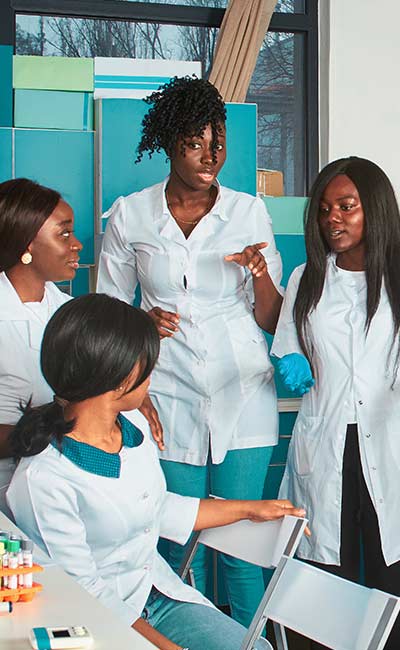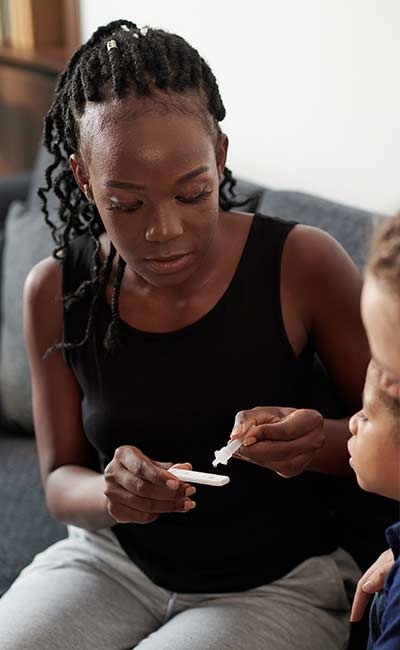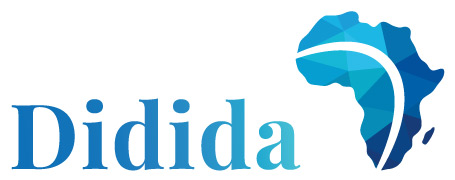Get to know what we are fighting for
Infectious diseases remain the leading causes of death in Africa, while non-communicable diseases are on the rise. Improving detection and prevention tools, especially in areas far from health care centres, is an important measure to reduce the growing burden of these diseases.


About diseases
What are infectious diseases?
Infectious diseases are caused by micro-organisms: bacteria, viruses, parasites and fungi. They can be transmitted directly or indirectly from one person to another, for example through insect bites, ingestion of contaminated water or food. Diseases such as tuberculosis and influenza can be transmitted by coughing, sneezing, saliva or mucus on unwashed hands. A major cause of death in Africa is lower respiratory tract infections, including pneumonia, influenza, bronchitis and tuberculosis.
Insects are one of the main vectors of disease transmission. One of the biggest killers in Africa is malaria, a blood disease that humans get from parasites in mosquitoes. The infected mosquito bites you, the parasites get into your blood and destroy your red blood cells. In 2021, about 241 million cases of malaria were reported worldwide, resulting in about 429,000 deaths. 90% of these cases, and 92% of these deaths, occurred in Africa. Malaria is particularly dangerous for children under 5 years of age and pregnant women.
Sexually transmitted infections such as HIV and viral hepatitis are transmitted through body fluids such as blood, vaginal secretions and semen.
What are non-communicable diseases?
Non-communicable diseases such as cancer, cardiovascular disease and diabetes are increasingly becoming the leading cause of death in sub-Saharan Africa. They were responsible for 37% of deaths in 2019, up from 24% in 2000 according to the WHO. At the same time, these diseases are putting increasing pressure on health care services. In the African region, the number of people living with diabetes, for example, is expected to reach 47 million by 2045, up from 19 million in 2019.
Improving tools for detection and prevention is an important measure to reduce the growing burden of non-communicable diseases, especially in areas far from health care facilities.
Why is Africa particularly affected?
Some of the highest rates of disease in the world are found in sub-Saharan African countries, particularly among children. Many diseases are caused by unsafe water, poor housing conditions, lack of hygiene or lack of prevention, diagnostic and care, whilst malnutrition is also a common contributor to illness. This shows that most of these deaths can be prevented with appropriate prevention, detection and care measures.
About DIDIDA diagnostic tests
What is a lateral flow test?
Lateral flow tests are a fast, reliable and low-cost tool for disease testing. A sample (often as a swab or a drop of blood) is taken from the patient, and placed in a well on a small device. The fluid from the sample then flows naturally up a strip of dedicated paper. If protein or nucleic acid (DNA or RNA) of a disease are detected, a line of bright colour appears. A second line confirms that the test has worked. These tests are comparable in their operation to a pregnancy test.
Are these tests reliable?
Some lateral flow tests can detect the disease before it has had a chance to infect the person enough for their immune system to mount a strong enough response to attack it. DIDIDA will develop tests that detect disease even when patients are symptomless.
Since the Covid pandemic, these tests have proven effective, especially on a large scale. The results are reliable. Incorrect results are often due to improperly collected samples or a faulty device.
What will DIDIDA's technology achieve?
DIDIDA will develop an improved lateral flow test capable of detecting multiple diseases at once. The technology starts with a receptacle that is sealed after the sample is collected to reduce the risk of contamination. The test also relies on a small heating system. This is a simple isothermal amplification method called loop-mediated isothermal amplification (LAMP). By amplifying, the test is able to detect the DNA or RNA of a disease. This innovation allows for community-based testing in remote locations without access to health infrastructure.


About DIDIDA digital health technology
Why will DIDIDA's test be connected by mobile?
By sending the test results via smartphone, the user receives better medical treatment and contributes to improving the health of the population in their region. Indeed, an algorithm on the remote server analyses the results and aggregated and geo-localised data from the results then allows health authorities to monitor disease patterns in real time and respond more quickly and effectively.
By uploading the data to secure servers, the user also keeps a history of his or her care. The healthcare workers can therefore prescribe more appropriate care based on the test results and taking into account his other medical history. The system builds on the widespread adoption of mobile health and payment systems in sub-Saharan Africa.
Why is this solution appropriate in rural areas?
By linking the test to mobile phones, it will provide access to high-quality diagnostic assays in areas with limited health infrastructure. There already exist a large number of mobile healthcare services in Africa. These already provide a variety of services that have had significant healthcare outcomes, as well as reducing supply costs and decreasing drug counterfeiting.
How secure is the data collected?
The tools will be deployed on a secure, open-source app linking individual and aggregated data into pertinent national data systems. Many countries in sub-Saharan Africa use DHIS2 for example as a health information management system to collect and collate digital information.
DIDIDA complies with the data protection regulations of each country where the project is based. Several partners have a proven experience in managing confidential data such as PharmAccess.
Want to know more?
Are you a student and you want to learn more? A researcher seeking to consult our publications? A citizen eager to better understand the issues? A decision-maker who can promote this innovation? A journalist looking for an engaging story to tell?
